Estimating Liquefaction Susceptibility Using Machine Learning Algorithms with a Case of Metro Manila, Philippines
Abstract
1. Introduction
2. Methodology
2.1. Data
2.2. Density of Boreholes
2.3. Microzonation
2.4. Training and Modelling
2.4.1. Modelling Process
2.4.2. Modelling of Site-Specific Properties
2.4.3. Modelling of Geotechnical Strength Parameters
2.4.4. Modelling Liquefaction Susceptibility
2.5. Case Study
2.6. Validation
3. Results and Discussions
3.1. Models
3.1.1. Site-Specific Models
3.1.2. Calibrated Models
3.2. Case Study: Metro Manila, Philippines
3.3. Validation
4. Conclusions
Author Contributions
Funding
Institutional Review Board Statement
Informed Consent Statement
Data Availability Statement
Acknowledgments
Conflicts of Interest
References
- Youd, T.L.; Idriss, I.M. Liquefaction Resistance of Soils: Summary Report from the 1996 NCEER and 1998 NCEER/NSF Workshops on Evaluation of Liquefaction Resistance of Soils. J. Geotech. Geoenviron. Eng. 2001, 127, 297–313. [Google Scholar] [CrossRef]
- Holzer, T.L.; Jayko, A.S.; Hauksson, E.; Fletcher, J.P.B.; Noce, T.E.; Bennett, M.J.; Dietel, C.M.; Hudnut, K.W. Liquefaction caused by the 2009 Olancha, California (USA), M5.2 earthquake. Eng. Geol. 2010, 116, 184–188. [Google Scholar] [CrossRef]
- Muhammad, N.; Namdar, A.; Zakaria, I.B. Liquefaction mechanisms and mitigation-a review. Res. J. Appl. Sci. Eng. Technol. 2013, 5, 574–578. [Google Scholar] [CrossRef]
- Juang, C.H.; Yang, S.H.; Yuan, H.; Fang, S.Y. Liquefaction in the Chi-Chi earthquake-effect of fines and capping non-liquefiable layers. Soils Found. 2005, 45, 89–101. [Google Scholar] [CrossRef]
- Isobe, K.; Ohtsuka, S.; Nunokawa, H. Field investigation and model tests on differential settlement of houses due to liquefaction in the Niigata-ken Chuetsu-Oki earthquake of 2007. Soils Found. 2014, 54, 675–686. [Google Scholar] [CrossRef]
- Sarah, D.; Soebowo, E. Liquefaction due to the 2006 Yogyakarta Earthquake: Field Occurrence and Geotechnical Analysis. Procedia Earth Planet. Sci. 2013, 6, 383–389. [Google Scholar] [CrossRef]
- Marcuson, W.F. Definition of terms related to liquefaction. J. Geotech. Engrg. Div. 1978, 104, 1197–1200. [Google Scholar]
- Beyzaei, C.Z.; Bray, J.D.; van Ballegooy, S.; Cubrinovski, M.; Bastin, S. Depositional environment effects on observed liquefaction performance in silt swamps during the Canterbury earthquake sequence. Soil Dyn. Earthq. Eng. 2018, 107, 303–321. [Google Scholar] [CrossRef]
- Mojtahedzadeh, N.; Siddharthan, R. Estimating free field seismic settlement history in a saturated layered soil profile. Soil Dyn. Earthq. Eng. 2021, 150, 106937. [Google Scholar] [CrossRef]
- Kteich, Z.; Labbé, P.; Javelaud, E.; Semblat, J.F.; Bennabi, A. Extended equivalent linear model (X-ELM) to assess liquefaction triggering: Application to the City of Urayasu during the 2011 Tohoku earthquake. Soils Found. 2019, 59, 750–763. [Google Scholar] [CrossRef]
- Kang, G.C.; Chung, J.W.; Rogers, J.D. Re-calibrating the thresholds for the classification of liquefaction potential index based on the 2004 Niigata-ken Chuetsu earthquake. Eng. Geol. 2014, 169, 30–40. [Google Scholar] [CrossRef]
- Wijewickreme, D.; Atukorala, U.D. Chapter 16 Ground improvement for mitigating liquefaction-induced geotechnical hazards. In Elsevier Geo-Engineering Book Series; Elsevier: Amsterdam, The Netherlands, 2005; Volume 3, pp. 447–489. [Google Scholar]
- Venkata, N.; Kumar Velpuri, P. Factors Influencing the Microbial Calcium Carbonate Precipitation Performance in Sands; The University of Texas at Arlington: Arlington, TX, USA, 2015. [Google Scholar]
- Karim, H.H. Evaluation of Some Geotechnical Properties and Liquefaction Potential from Seismic Parameters. Iraqi J. Civ. Eng. 2010, 6, 30–45. [Google Scholar]
- Uy, E.E.S.; Adajar, M.A.Q.; Galupino, J.G. Utilization of Philippine gold mine tailings as a material for geopolymerization. Int. J. GEOMATE 2021, 21, 28–35. [Google Scholar]
- Galupino, J.; Dungca, J. Machine learning models to generate a subsurface soil profile: A case of Makati City, Philippines. Int. J. GEOMATE 2022, 23, 57–64. [Google Scholar] [CrossRef]
- Galupino, J.G.; Dungca, J.R. Quezon City soil profile reference. Int. J. GEOMATE 2019, 16, 48–54. [Google Scholar] [CrossRef]
- Look, B. Handbook of Geotechnical Investigation and Design Tables; Taylor & Francis/Balkema: Leiden, The Netherlands, 2007; pp. 1–356. [Google Scholar]
- Dungca, J.R.; Chua, R.A.D. Development of a probabilistic liquefaction potential map for Metro Manila. Int. J. GEOMATE 2016, 10, 1804–1809. [Google Scholar]
- Peck, R.; Hanson, W.; Thornburn, T. Foundation Engineering, 2nd ed.; John Wiley & Sons: Hoboken, NJ, USA, 1974; Volume 2. [Google Scholar]
- Geyin, M.; Maurer, B.W.; Christofferson, K. An AI driven, mechanistically grounded geospatial liquefaction model for rapid response and scenario planning. Soil Dyn. Earthq. Eng. 2022, 159, 107348. [Google Scholar] [CrossRef]
- Ameratunga, J.; Sivakugan, N.; Das, B.M. Correlations of Soil and Rock Properties in Geotechnical Engineering; Springer: Berlin/Heidelberg, Germany, 2016. [Google Scholar]
- Valverde-Palacios, I.; Valverde-Espinosa, I.; Irigaray, C.; Chacón, J. Geotechnical map of Holocene alluvial soil deposits in the metropolitan area of Granada (Spain): A GIS approach. Bull. Eng. Geol. Environ. 2014, 73, 177–192. [Google Scholar] [CrossRef]
- Finn, W.D.L.; Dowling, J.; Ventura, C.E. Evaluating liquefaction potential and lateral spreading in a probabilistic ground motion environment. Soil Dyn. Earthq. Eng. 2016, 91, 202–208. [Google Scholar] [CrossRef]
- Lee, D.H.; Ku, C.S.; Yuan, H. A study of the liquefaction risk potential at Yuanlin, Taiwan. Eng. Geol. 2004, 71, 97–117. [Google Scholar] [CrossRef]
- Kim, H.S.; Kim, M.; Baise, L.G.; Kim, B. Local and regional evaluation of liquefaction potential index and liquefaction severity number for liquefaction-induced sand boils in pohang, South Korea. Soil Dyn. Earthq. Eng. 2021, 141, 106459. [Google Scholar] [CrossRef]
- Dawson, K.M.; Baise, L.G. Three-dimensional liquefaction potential analysis using geostatistical interpolation. Soil Dyn. Earthq. Eng. 2005, 25, 369–381. [Google Scholar] [CrossRef]
- Gajurel, A.; Chittoori, B.; Mukherjee, P.S.; Sadegh, M. Machine learning methods to map stabilizer effectiveness based on common soil properties. Transp. Geotech. 2021, 27, 100506. [Google Scholar] [CrossRef]
- Dungca, J.R.; Galupino, J.G. Artificial neural network permeability modeling of soil blended with fly ash. Int. J. GEOMATE 2017, 12, 76–83. [Google Scholar] [CrossRef]
- Pal, M.; Singh, N.K.; Tiwari, N.K. M5 model tree for pier scour prediction using field dataset. KSCE J. Civ. Eng. 2012, 16, 1079–1084. [Google Scholar] [CrossRef]
- Ghani, S.; Kumari, S.; Bardhan, A. A novel liquefaction study for fine-grained soil using PCA-based hybrid soft computing models. Sādhanā 2021, 46, 113. [Google Scholar] [CrossRef]
- Ghani, S.; Kumari, S.; Ahmad, S. Prediction of the Seismic Effect on Liquefaction Behavior of Fine-Grained Soils Using Artificial Intelligence-Based Hybridized Modeling. Arab. J. Sci. Eng. 2022, 47, 5411–5441. [Google Scholar] [CrossRef]
- Ghani, S.; Kumari, S. Liquefaction behavior of Indo-Gangetic region using novel metaheuristic optimization algorithms coupled with artificial neural network. Nat. Hazards 2021, 111, 2995–3029. [Google Scholar] [CrossRef]
- Uy, E.E.S.; Dadios, E.P.; Dungca, J.R. Preliminary assessment of liquefiable area in Ermita, Manila using genetic algorithm. In Proceedings of the 8th International Conference on Humanoid, Nanotechnology, Information Technology, Communication and Control, Environment and Management, HNICEM 2015, Cebu City, Philippines, 9–12 December 2015. [Google Scholar]
- Wang, H.; Wang, X. Study of AI Based Methods for Characterization of Geotechnical Site Investigation Data; Ohio Department of Transportation, Office of Statewide Planning and Research: Columbus, OH, USA, 2020. [Google Scholar]
- Ahmed, C.; Mohammed, A.; Tahir, A. Geostatistics of strength, modeling and GIS mapping of soil properties for residential purpose for Sulaimani City soils, Kurdistan Region, Iraq. Model. Earth Syst. Environ. 2020, 6, 879–893. [Google Scholar] [CrossRef]
- Shi, C.; Wang, Y. Non-parametric machine learning methods for interpolation of spatially varying non-stationary and non-Gaussian geotechnical properties. Geosci. Front. 2021, 12, 339–350. [Google Scholar] [CrossRef]
- University of Southern California. Uses of Geospatial Intelligence. 2021. Available online: https://gis.usc.edu/blog/4-uses-of-geospatial-intelligence/ (accessed on 10 May 2023).
- Wojtkowska, M.; Kedzierski, M.; Delis, P. Validation of terrestrial laser scanning and artificial intelligence for measuring deformations of cultural heritage structures. Meas. J. Int. Meas. Confed. 2021, 167, 108291. [Google Scholar] [CrossRef]
- Depellegrin, D.; Hansen, H.S.; Schrøder, L.; Bergström, L.; Romagnoni, G.; Steenbeek, J.; Gonçalves, M.; Carneiro, G.; Hammar, L.; Pålsson, J.; et al. Current status, advancements and development needs of geospatial decision support tools for marine spatial planning in European seas. Ocean Coast. Manag. 2021, 209, 105644. [Google Scholar] [CrossRef]
- Tien Bui, D.; Nhu, V.H.; Hoang, N.D. Prediction of soil compression coefficient for urban housing project using novel integration machine learning approach of swarm intelligence and Multi-layer Perceptron Neural Network. Adv. Eng. Inform. 2018, 38, 593–604. [Google Scholar] [CrossRef]
- Efthimiou, N.; Psomiadis, E.; Panagos, P. Fire severity and soil erosion susceptibility mapping using multi-temporal Earth Observation data: The case of Mati fatal wildfire in Eastern Attica, Greece. Catena 2020, 187, 104320. [Google Scholar] [CrossRef]
- Azarakhsh, Z.; Azadbakht, M.; Matkan, A. Estimation, modeling, and prediction of land subsidence using Sentinel-1 time series in Tehran-Shahriar plain: A machine learning-based investigation. Remote Sens. Appl. Soc. Environ. 2022, 25, 100691. [Google Scholar] [CrossRef]
- Meshesha, D.T.; Tsunekawa, A.; Haregeweyn, N. Determination of soil erodibility using fluid energy method and measurement of the eroded mass. Geoderma 2016, 284, 13–21. [Google Scholar] [CrossRef]
- Naderpour, M.; Rizeei, H.M.; Khakzad, N.; Pradhan, B. Forest fire induced Natech risk assessment: A survey of geospatial technologies. Reliab. Eng. Syst. Saf. 2019, 191, 106558. [Google Scholar] [CrossRef]
- Saraygord Afshari, S.; Enayatollahi, F.; Xu, X.; Liang, X. Machine learning-based methods in structural reliability analysis: A review. Reliab. Eng. Syst. Saf. 2022, 219, 108223. [Google Scholar] [CrossRef]
- Bishop, C. Pattern Recognition and Machine Learning; EAI/Springer Innovations in Communication and Computing: New York, NY, USA, 2006. [Google Scholar]
- Bowles, J.E. Foundation Analysis and Design. In Civil Engineering Materials; The McGraw-Hill Companies, Inc.: New York, NY, USA, 1997. [Google Scholar]
- Puri, N.; Prasad, H.D.; Jain, A. Prediction of Geotechnical Parameters Using Machine Learning Techniques. Procedia Comput. Sci. 2018, 125, 509–517. [Google Scholar] [CrossRef]
- Rahman, M. Foundation Design using Standard Penetration Test (SPT) N-value. Researchgate 2019, 5, 1–39. [Google Scholar]
- Anbazhagan, P.; Uday, A.; Moustafa, S.S.R.; Al-Arifi, N.S.N. Correlation of densities with shear wave velocities and SPT N values. J. Geophys. Eng. 2016, 13, 320–341. [Google Scholar] [CrossRef]
- Terzaghi, K.; Peck, R.; Mesr, G. Soil Mechanics in Engineering Practice; John Wiley & Sons, Inc.: Hoboken, NJ, USA, 1996. [Google Scholar]
- Dungca, J.R.; Montejo, M.F.G. Metropolitan Manila Seismic Hazard Map Using Midorikawa & Hori Site Amplification Model. Int. J. Geomate 2022, 22, 92–99. [Google Scholar]
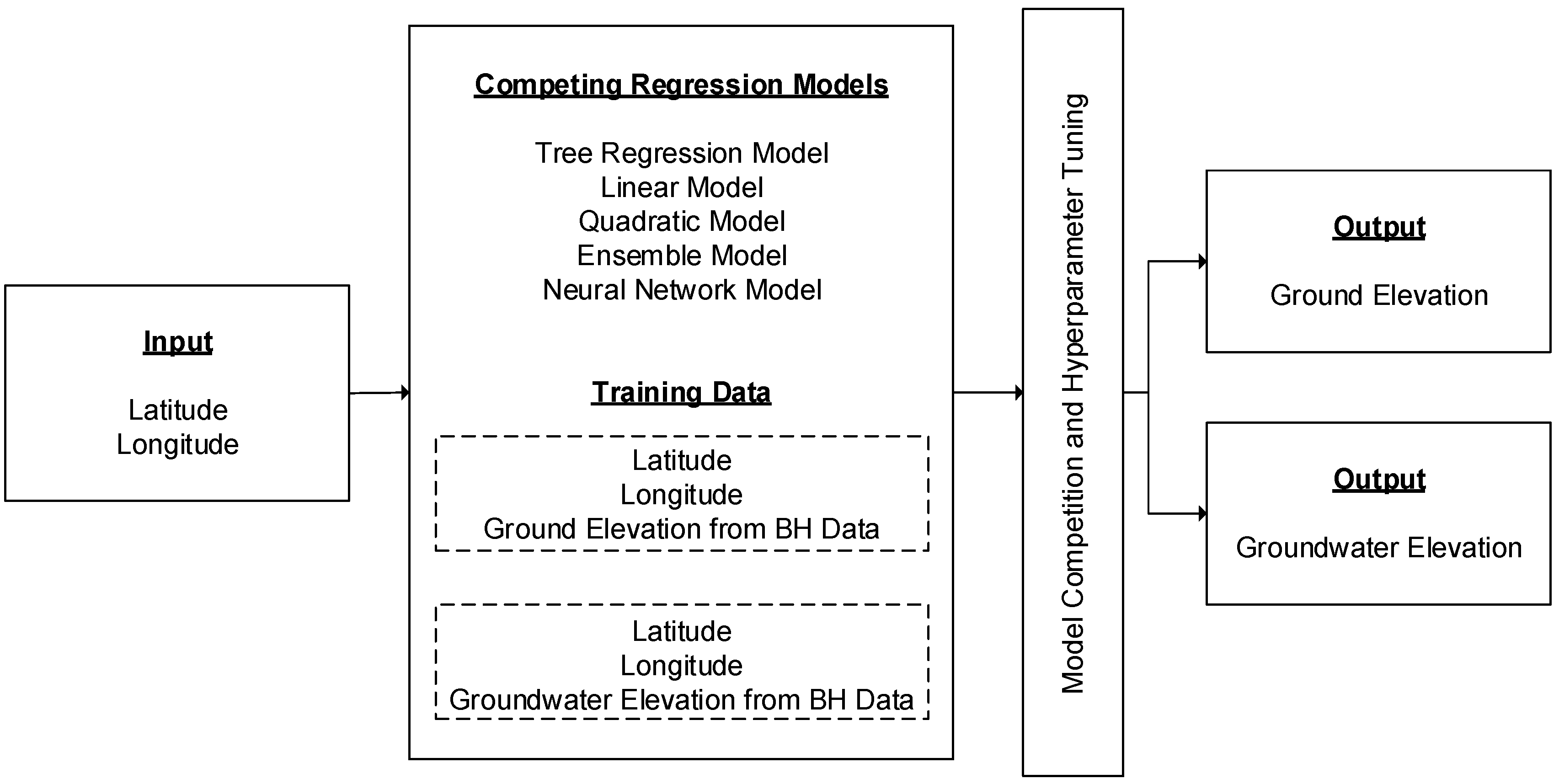
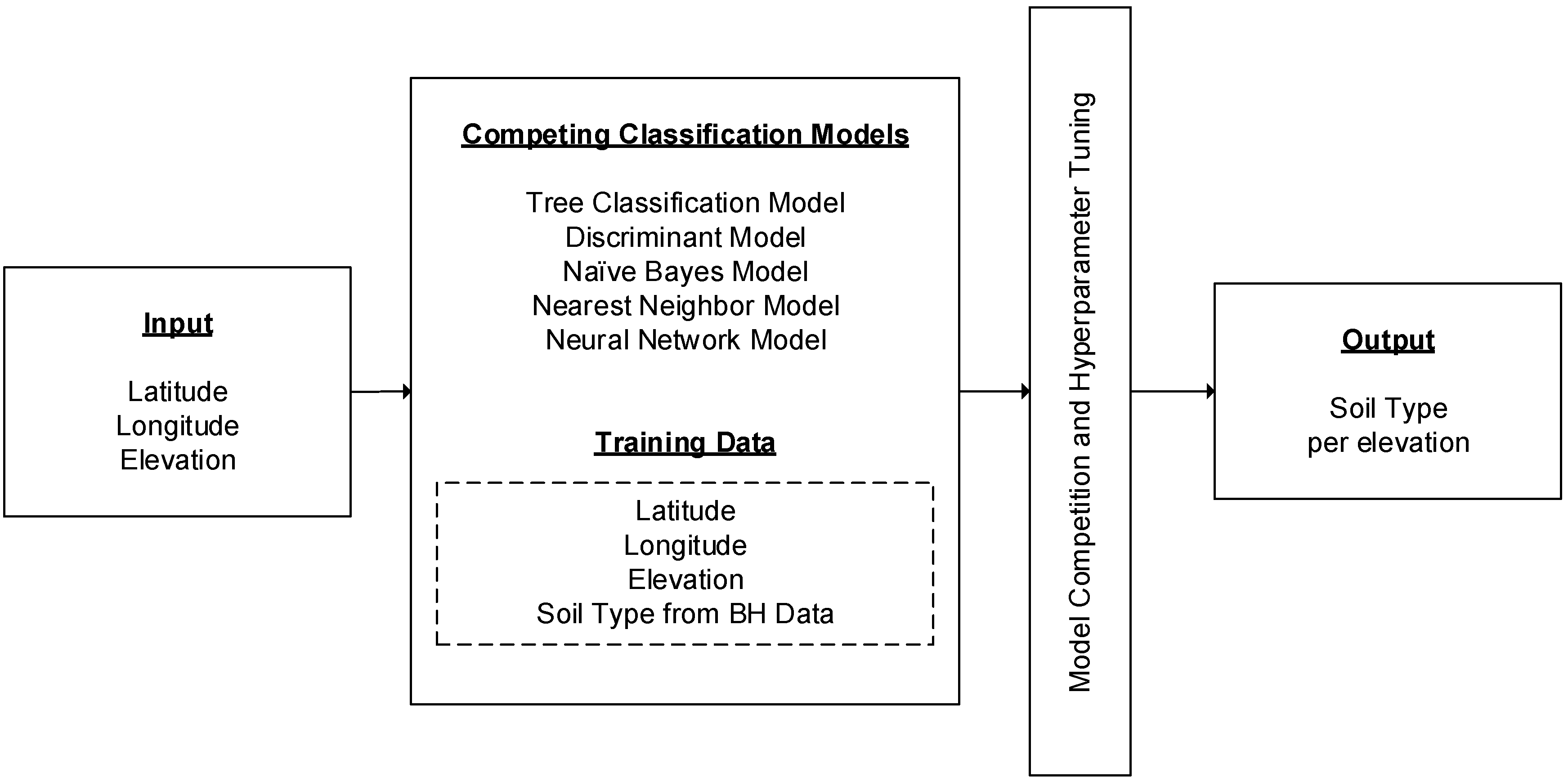
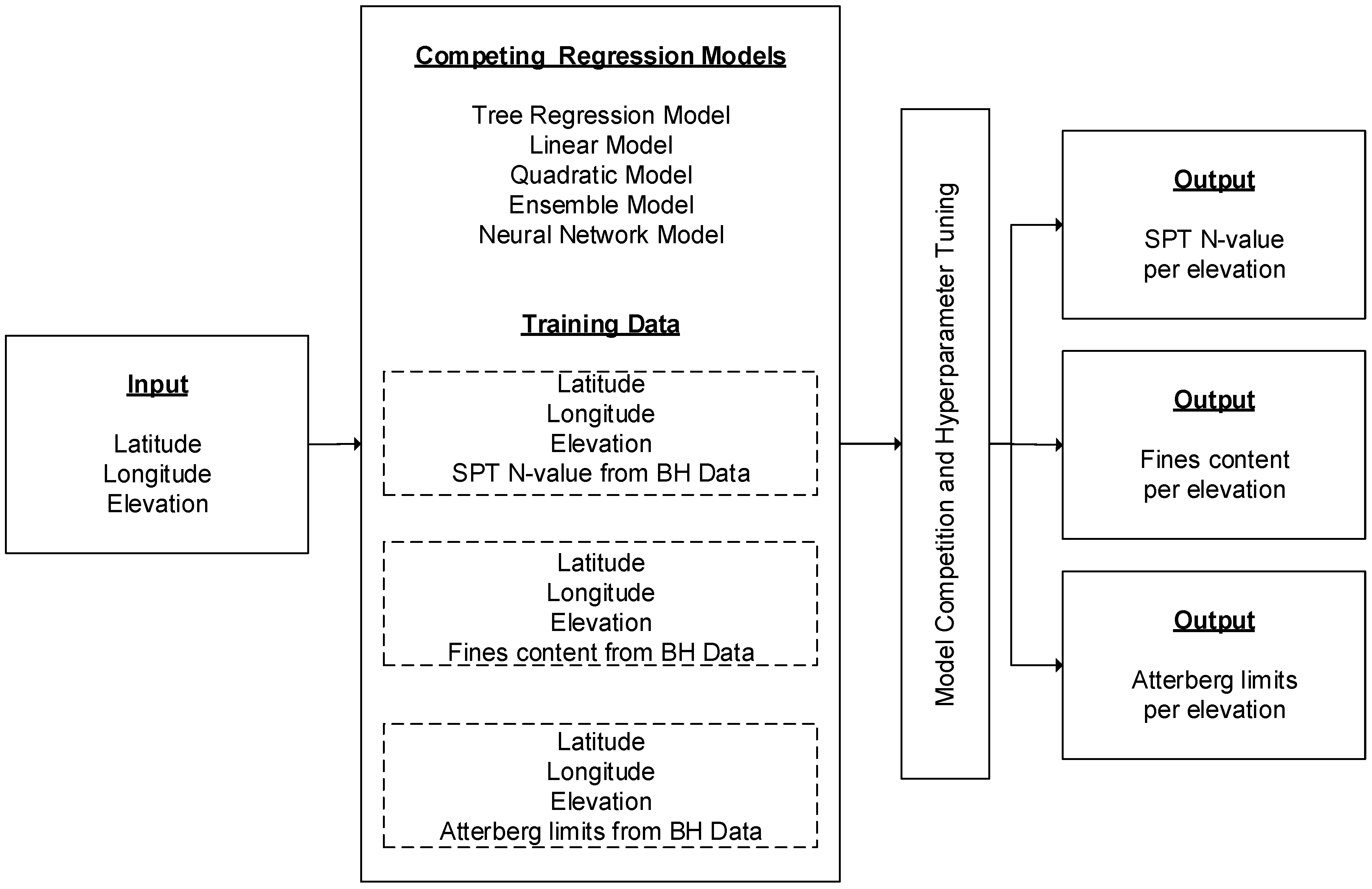

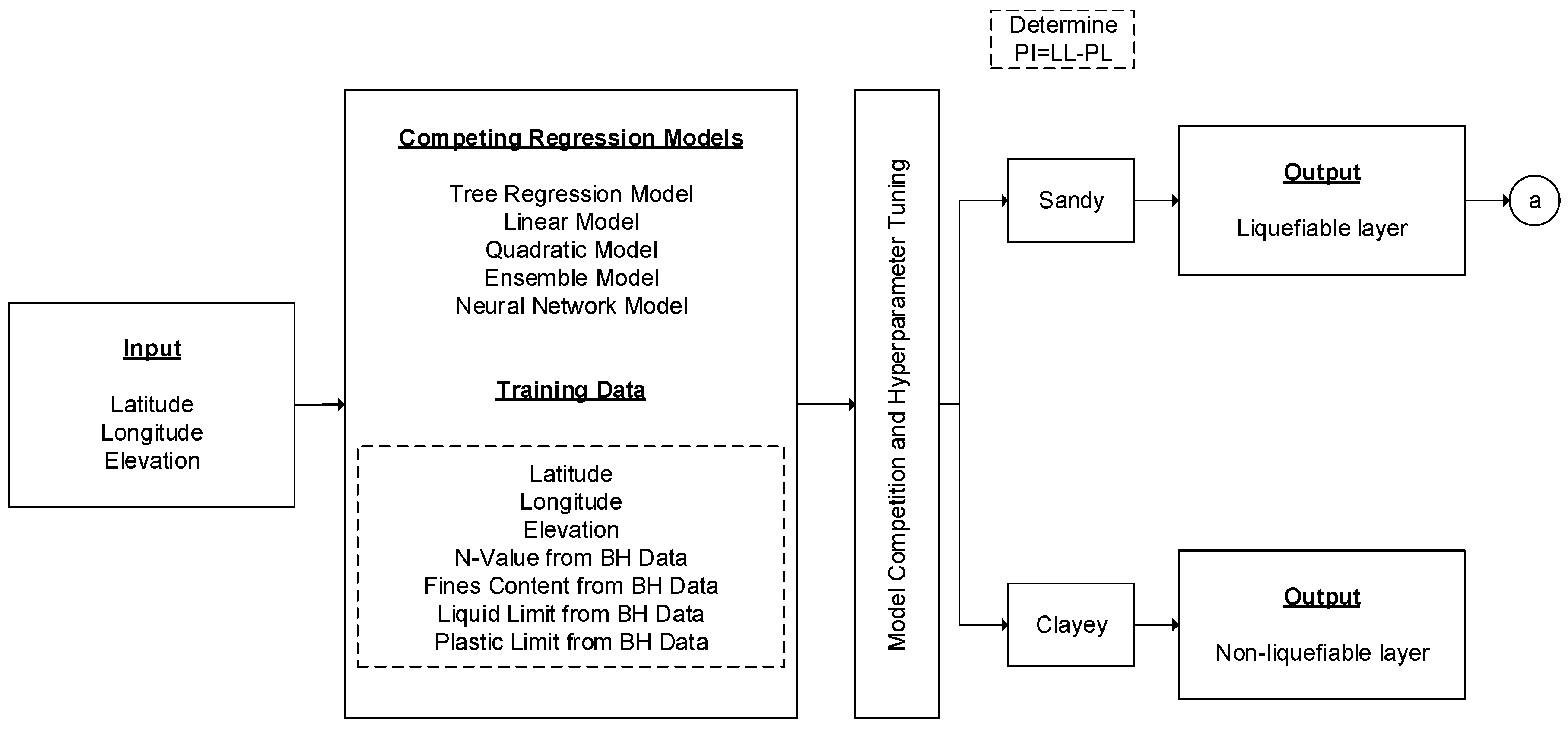
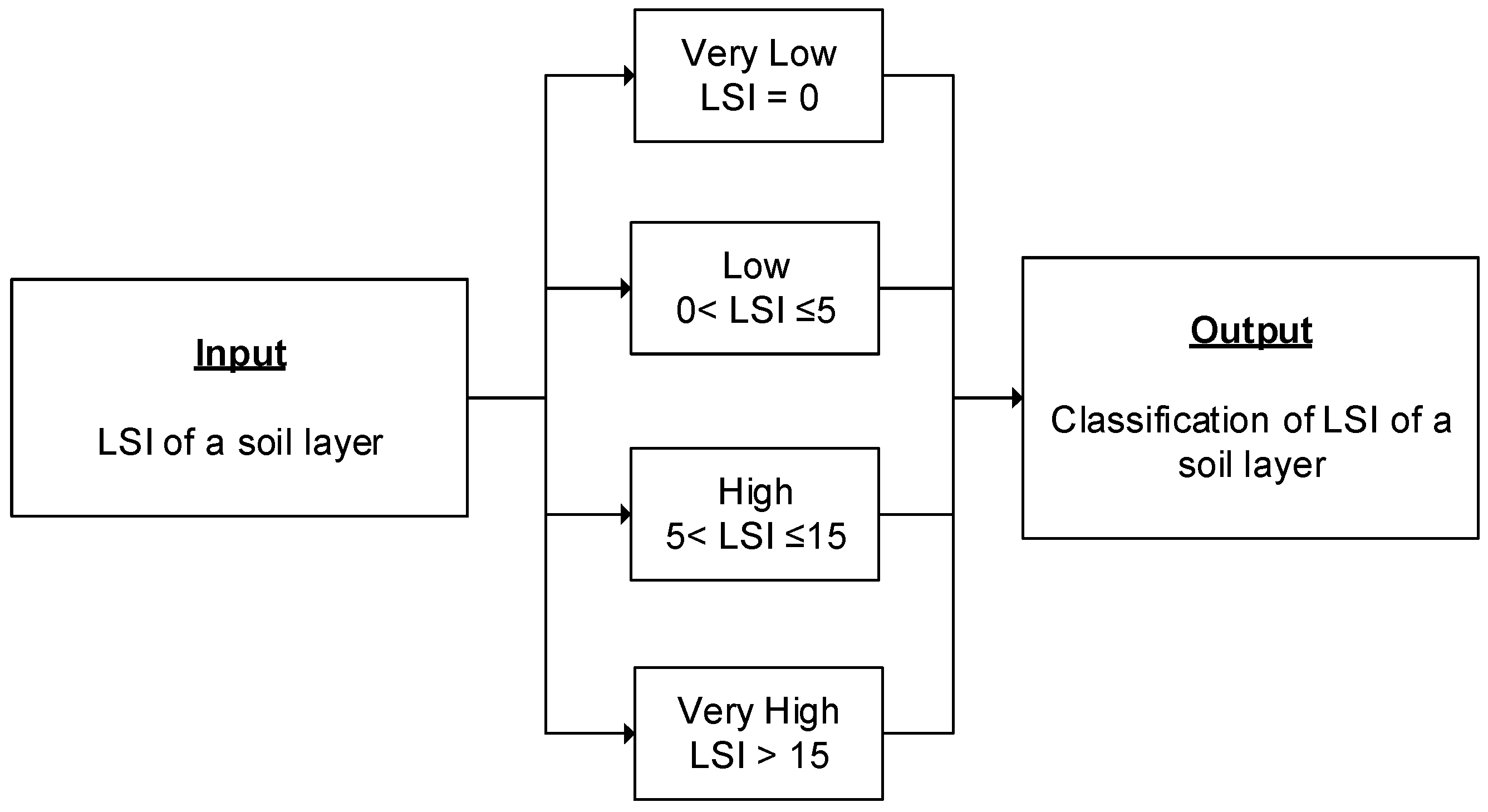

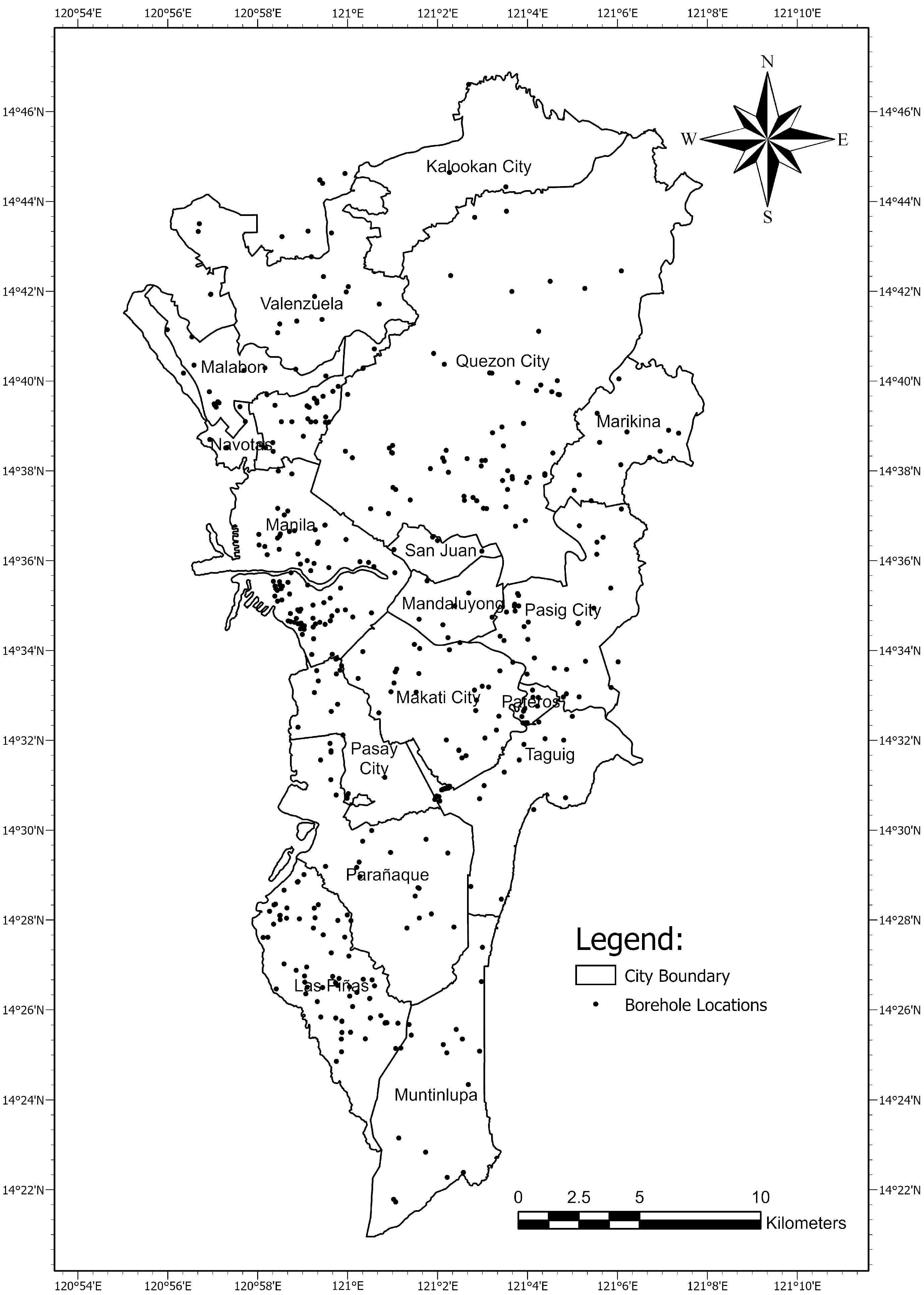
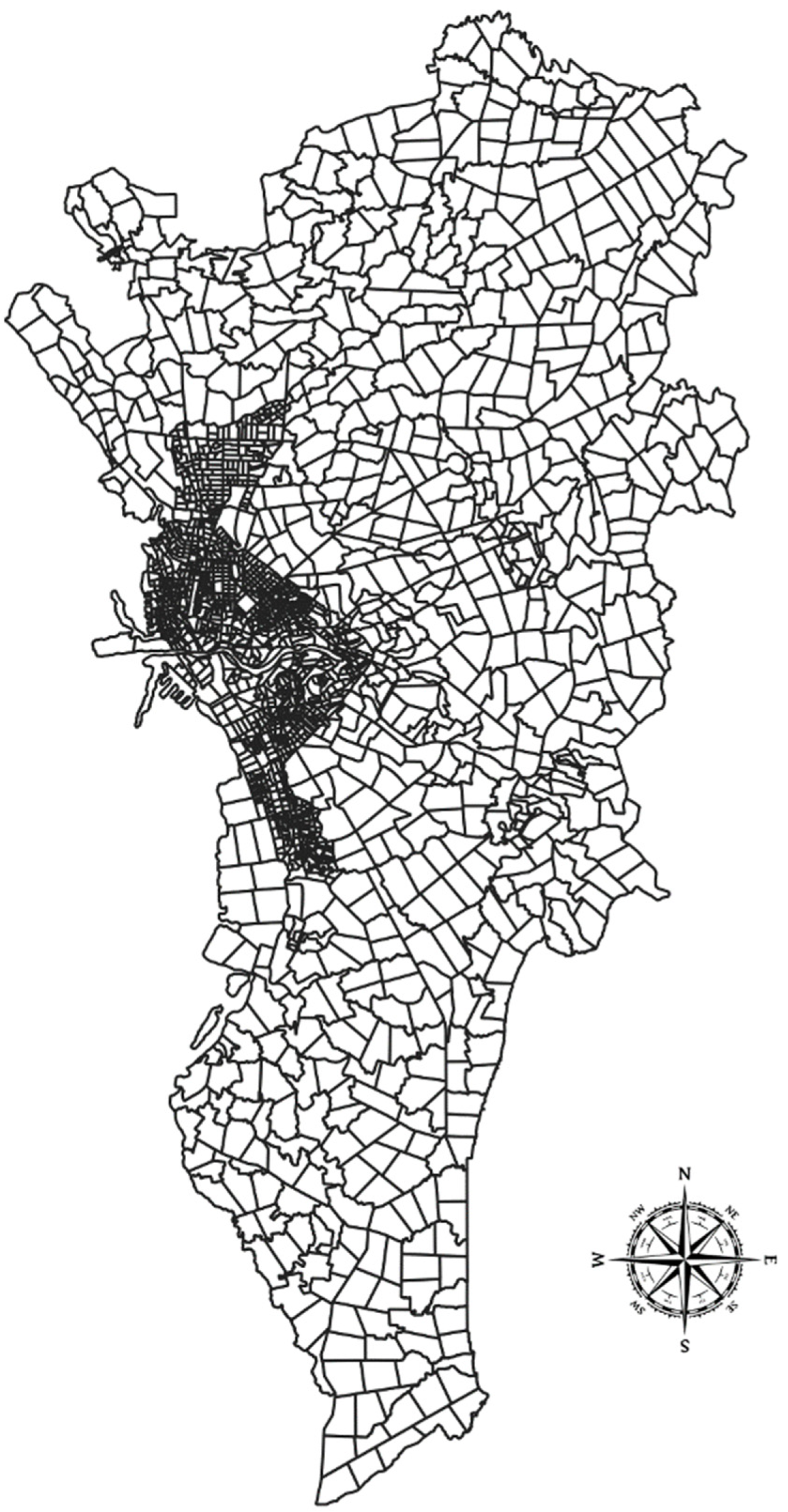
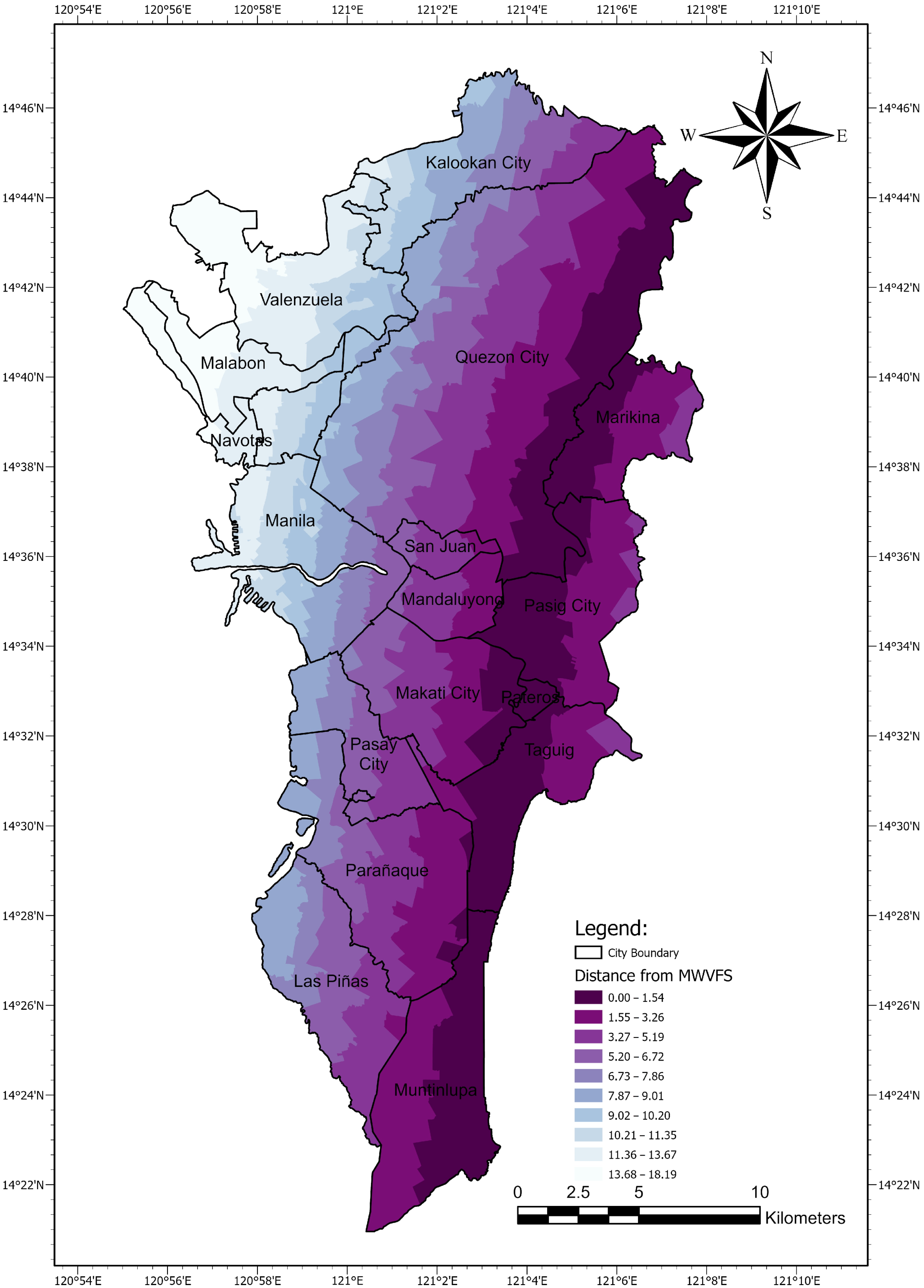
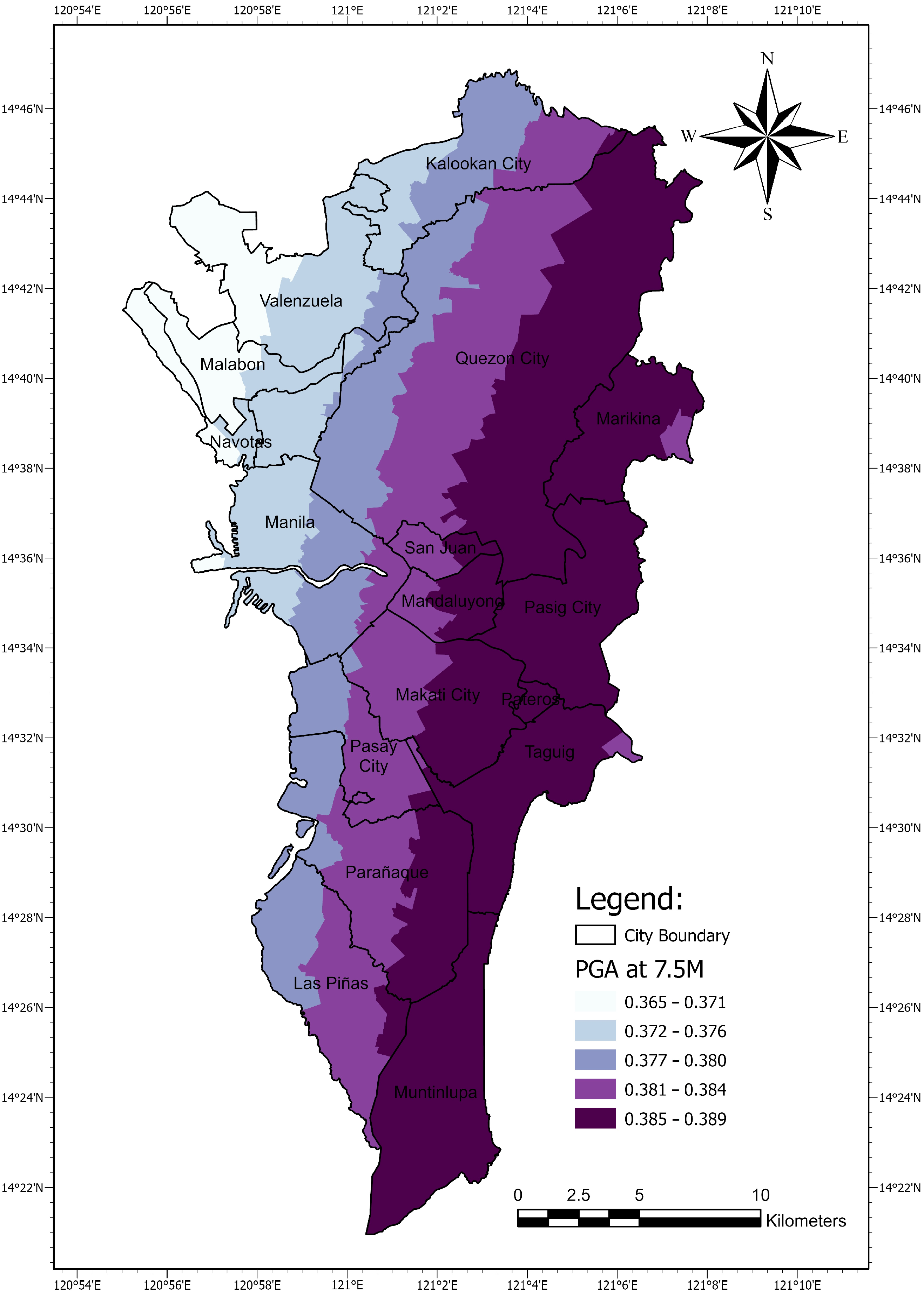
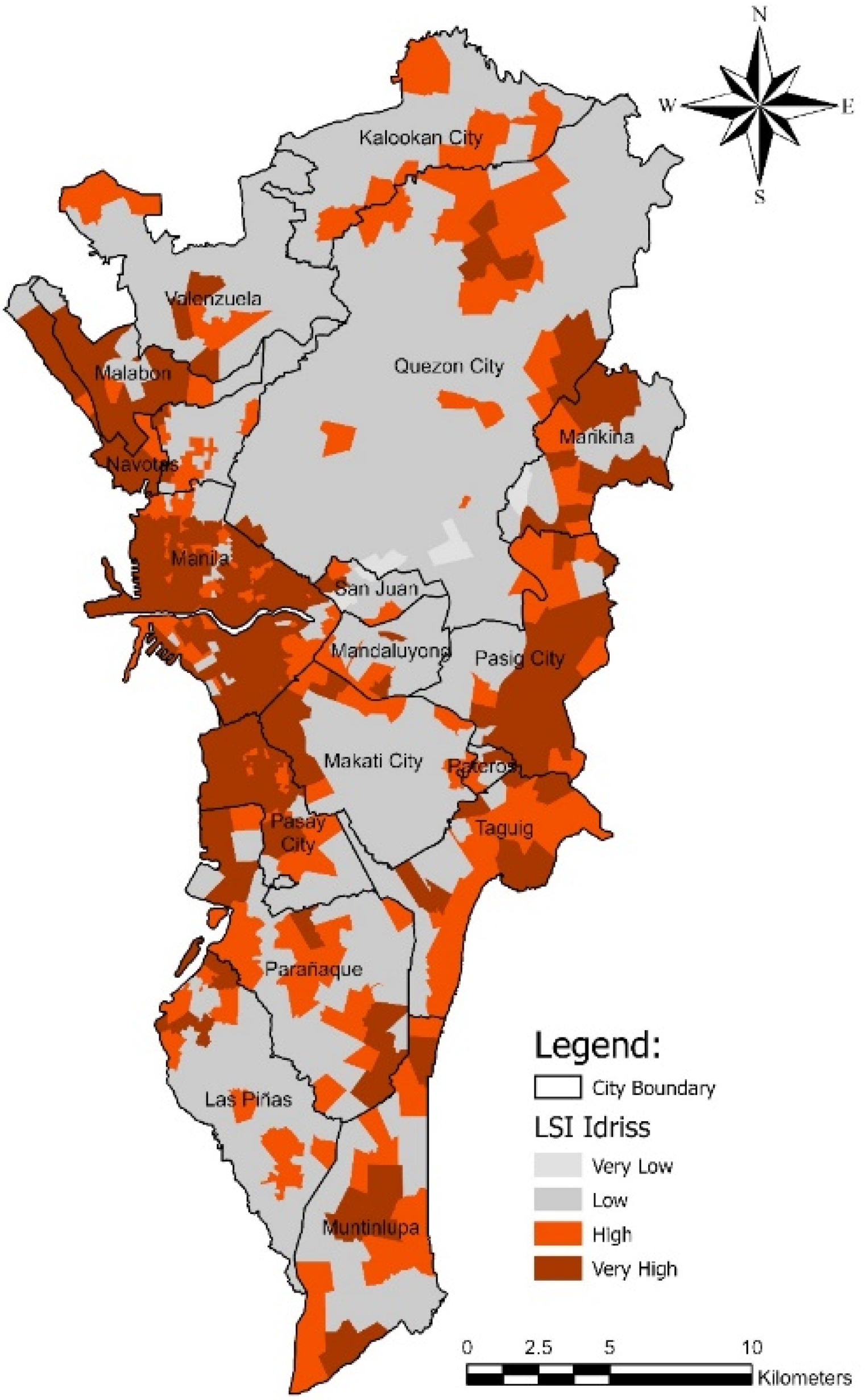
| Soil Group | Soil Type |
|---|---|
| Coarse-Grained Soils | GW, GP, GM, GC, SW, SP, SM, SC |
| Fine-Grained Soils | ML, CL, OL, MH, CH, OH |
| Parameter | Tree | Linear | Quadratic | Ensemble | Neural Network |
|---|---|---|---|---|---|
| Ground Elevation | 0.99 | 0.44 | 0.71 | 0.98 | 0.93 |
| Groundwater Table Elevation | 0.99 | 0.44 | 0.70 | 0.97 | 0.92 |
| SPT N-value | 0.88 | 0.09 | 0.25 | 0.50 | 0.46 |
| Fines Content | 0.76 | 0.05 | 0.16 | 0.48 | 0.30 |
| Parameter | Tree | Linear | Quadratic | Ensemble | Neural Network |
|---|---|---|---|---|---|
| Ground Elevation | 0.00 | 2.81 | 2.50 | 1.24 | 1.80 |
| Groundwater Table Elevation | 0.00 | 2.95 | 2.62 | 1.30 | 1.89 |
| SPT N-value | 7.33 | 20.24 | 18.41 | 15.09 | 15.73 |
| Fines Content | 13.78 | 27.60 | 25.97 | 20.38 | 23.75 |
| Parameter | Tree | Discriminant | Naive Bayes | Nearest Neighbor | Neural Network |
|---|---|---|---|---|---|
| Soil Type | 70.2 | 42.8 | 53.2 | 93.9 | 56.3 |
| Magnitude | Range of Peak Ground Acceleration (PGA) Magnitude | |
|---|---|---|
| Minimum in g | Maximum in g | |
| 5.0 | 0.12 | 0.15 |
| 6.0 | 0.22 | 0.24 |
| 7.0 | 0.32 | 0.34 |
| 7.5 | 0.37 | 0.39 |
Disclaimer/Publisher’s Note: The statements, opinions and data contained in all publications are solely those of the individual author(s) and contributor(s) and not of MDPI and/or the editor(s). MDPI and/or the editor(s) disclaim responsibility for any injury to people or property resulting from any ideas, methods, instructions or products referred to in the content. |
© 2023 by the authors. Licensee MDPI, Basel, Switzerland. This article is an open access article distributed under the terms and conditions of the Creative Commons Attribution (CC BY) license (https://creativecommons.org/licenses/by/4.0/).
Share and Cite
Galupino, J.; Dungca, J. Estimating Liquefaction Susceptibility Using Machine Learning Algorithms with a Case of Metro Manila, Philippines. Appl. Sci. 2023, 13, 6549. https://doi.org/10.3390/app13116549
Galupino J, Dungca J. Estimating Liquefaction Susceptibility Using Machine Learning Algorithms with a Case of Metro Manila, Philippines. Applied Sciences. 2023; 13(11):6549. https://doi.org/10.3390/app13116549
Chicago/Turabian StyleGalupino, Joenel, and Jonathan Dungca. 2023. "Estimating Liquefaction Susceptibility Using Machine Learning Algorithms with a Case of Metro Manila, Philippines" Applied Sciences 13, no. 11: 6549. https://doi.org/10.3390/app13116549
APA StyleGalupino, J., & Dungca, J. (2023). Estimating Liquefaction Susceptibility Using Machine Learning Algorithms with a Case of Metro Manila, Philippines. Applied Sciences, 13(11), 6549. https://doi.org/10.3390/app13116549









